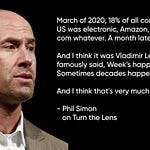The Cray-1 super computer used 115 kW continuous power, 92x times the average US home. A modern smart phone uses 2 - 4 Watts, when working hard, can spike to 8 to 12 Watts. The phone can do 4,000 times more work than the Cray. -
It’s crazy to think that for 4,000 times more work, you're paying a fraction of the cost. A $1,000 smartphone today delivers 4,000 times the computational power of a Cray-1, which cost $40 million back then. - Jeff Frick
Lots of talk about the power consumption happening to support the data centers that support GenAI
Exponential curves apply to power consumption too (along with cost and power).
In the '70s, the Cray-1 super computer used as much electricity in a day, ad 4 homes in a month. 115 kW. Today, a modern smart phone delivers thousands of times more computer for a tiny fraction of the power (and cost)
That curve is only getting steeper.
Exponential curves make it hard to perceive the future, and how fast things move. After taking in an evening with Ray Kurzweil, and Interview with Jack Nilles, I had to find some meaningful, 'comprehensible' comps.
Computing - memory, CPU, storage, bandwidth, power, cost.
Full length exploration
Exponential Curves: Supercomputer to Smartphone to Singularity | Turn the Lens Jeff Frick -
- Transcript, Prompts, Calculations, and Show notes - https://www.turnthelenspodcast.com/episode/exponential-curves-supercomputer-to-smartphone-to-singularity-turn-the-lens-ep39
- or wherever you podcast
#Power #DataCenter #ExponentialCurves #Supercomputers #Smartphones #Singularity #GenAI #AGI #AI #ComputingPower #Cost #CostVsPerformance #Cray #DataCenters #Efficiency #Electricity #ExponentialGrowth #FutureOfTech #JackNilles #JohnMNilles #MooresLaw #Podcast #RayKurzweil #Smartphone #SuperComputer #TechEvolution #TechHistory #Technology #TechnologyAdvances #TheGrid #TurnTheLens












Share this post